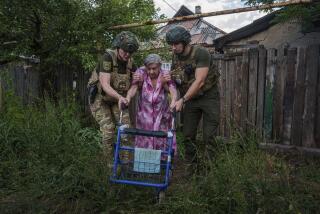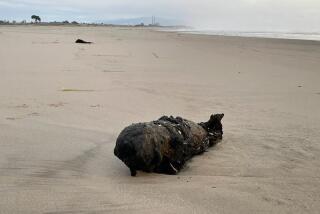Old Photos Help Germans Find World War II Bombs
- Share via
KIEL, West Germany — On April 14, 1945, a British bomber took a deep dive over the German navy’s most important shipyard in Kiel and dropped its bombs.
As it did so, an automatic camera in the plane clicked away, recording the destruction.
This May, on a beach not far from where the navy shipyards used to be, a bomb disposal squad carefully dug its way toward a huge dirty gray-green metal monster.
It was a live 1-ton bomb.
Heinz Wambold and his crew defused the British bomb they had found with the help of aerial photographs taken during the raid.
27 Bombs Disarmed
It was one of 27 bombs disarmed with the help of pictures in the first three months of this year.
“No question about it: Without the pictures it would have been a lot more difficult for us to find the thing,” Wambold, head of the Schleswig-Holstein bomb disposal squad, said.
About 500,000 bombs were dropped on Kiel from 1941, when the Allied bombing raids on Germany started, until the end of the war in May, 1945. About 80% of the city was destroyed.
“I believe most of Kiel’s built-up areas are safe now,” Wambold said. “But until 1974 we had to check out every piece of land for bombs when someone wanted to build a house on it.”
Manufacturers Praised
Despite the dangerous work, the Schleswig-Holstein experts are full of praise for the British bomb manufacturers.
“Fantastic workmanship and quality,” Wambold said. “Look at the steel. Not a dent in this baby. Must be Sheffield steel. And here, the detonator, still in working order after all these years.”
West Germany has been negotiating with Britain for some years for the release of the wartime photographs to help the country’s 1,200 bomb disposal experts.
Last year the first pictures were sent to Germany from Keele University, where they were stored in the aerial photography library.
1 Million Photos
So far, the Schleswig-Holstein bomb squad has received 50,000 photographs, and Wambold expects another 120,000. About 1 million pictures have been ordered.
The pictures, which will make the bomb search with metal detectors a thing of the past, will enable the squad to pinpoint a bomb within a five-yard radius from where it dropped.
The yellowing but otherwise clear photographs are being examined by experts at the bomb squad headquarters 12 miles north of Kiel.
Wambold worries about what might happen if his men uncover bombs with chemical detonators, which make them especially deadly.
Often buried deep in the ground, these dud bombs could be detonated by the chemical devices at a slight change in temperature.
Four bomb squad men have been killed on duty in Schleswig-Holstein since the end of the war.
“We have been really lucky so far,” Wambold said. “In other states, especially the industrial Ruhr area, the death toll is a lot higher.”
More to Read
Sign up for Essential California
The most important California stories and recommendations in your inbox every morning.
You may occasionally receive promotional content from the Los Angeles Times.










